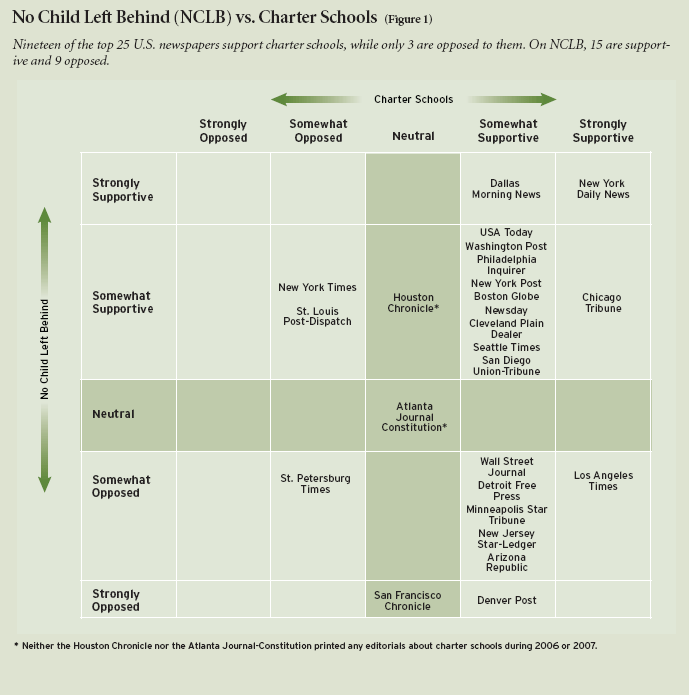Two reforms have dominated the education policy debates of the past decade: school choice as epitomized by charter schools, and testing and accountability as symbolized by No Child Left Behind (NCLB). Nine months ago we reported on public support for these reforms (“What Americans Think about Their Schools,” features, Fall 2007). Among the 58 percent of the American public who know enough about charter schools to have an opinion, three times as many favor as oppose them. NCLB divides the country, with 57 percent supporting its reauthorization with minimal or no changes and 43 percent wanting to end or radically mend it.
What about newspaper editorial boards, the original “opinion leaders”? Their writers have the luxury of time to follow important public-policy debates (as well as their own paper’s daily coverage), to interview key players, and to form well-honed views. How do they come out on these issues?
To find out, I asked three of my colleagues at the Thomas B. Fordham Institute to review all of the editorials written about or touching on charter schools or No Child Left Behind from 2006 and 2007 for the nation’s 25 largest-circulation papers. They had no shortage of reading material. Editorial boards commented on each subject extensively, with 201 editorials written about NCLB (an average of 8 per paper) and 183 about charters (an average of 7).
For both issues, the reviewers rated each newspaper on a Likert Scale, from negative 10 for “strongly opposed,” to positive 10 for “strongly supportive.” In every instance, at least two of the three reviewers agreed on the assessment and this was the value assigned to the paper. (In a majority of the cases, all three agreed.)
What did we find? As a group, the editorial boards share the general public’s views. The newspapers are much more supportive of charter schools than of No Child Left Behind, with charters receiving an average score of 4.1 (meaning the papers are “somewhat supportive” on average), compared to 1.2 for NCLB (meaning the papers are slightly better than neutral on average). Weighting the results by circulation gives the average ratings a small bump (to 4.3 and 1.3 respectively), but doesn’t change the story line.
Figure 1 shows how the individual papers scored. The charter school advantage is clear: 19 papers are somewhat or strongly supportive, versus only 3 that are somewhat opposed. (One is neutral and 2 did not write any editorials about the subject.) Meanwhile, the papers are split on NCLB, with 15 somewhat or strongly supportive, 9 somewhat or strongly opposed, and 1 neutral.
Taking into account the national papers’ political bent, the results are hardly surprising. USA Today and the Washington Post support both No Child Left Behind and charter schools, in line with their reputations as centrist or center-left papers. The New York Times supports the federal law but not charter schools, again not shocking for a liberal paper. (The Times titled one of its five editorials on the latter, “Exploding the Charter School Myth.”) And the conservative Wall Street Journal supports charters, but has misgivings about NCLB. Local context clearly has an impact. The Los Angeles Times is one of three papers to be “strongly supportive” of charter schools, which makes sense considering the frustrating pace of reform within the Los Angeles Unified School District (LAUSD) and the exciting development of L.A.-based charter management organizations such as Green Dot. Hence the paper’s stern admonition to LAUSD that it “learn from charters.”

The St. Louis Post-Dispatch is one of three papers to oppose charter schools, and their implementation in the “Gateway to the West” has been far from stellar. One editorial was titled “Charters Flunk.”
So are the “opinion leaders” driving the public’s views in a certain direction, or is it the other way around? It’s hard to know, but one thing’s for sure: the future of charter schools sure looks brighter than the future of No Child Left Behind.


